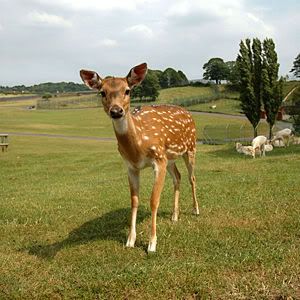Cervinae
Red Deer ( Cervus elaphus )
The Real deer ( Cervinae ) are a subfamily of the deer ( Cervidae ). The approximately 15 species of this group living mostly in Eurasia, the most famous of these is the red deer.
Features
They are characterized by a " plesiometacarpale " toe position ( ie that the proximal ( applied to the foot ) parts of the reduced 2nd and 5th toes are present only ). They share this characteristic with the Muntjakhirschen representing their closest relatives, but from which they differ significantly by the larger, more branched antlers.
System
The following types are distinguished:
- Genus Axishirsche (Axis ) Axis Deer ( Axis axis )
- Hog deer (Axis porcinus )
- Bawean deer (Axis kuhlii )
- Calamian deer (Axis calamianensis )
- Red Deer ( Cervus elaphus )
- Wapiti (Cervus canadensis)
- Sika deer (Cervus nippon)
- Fallow deer ( Dama dama)
- David Hirsch ( Elaphurus davidianus )
- White -lipped deer ( Przewalskium albirostris )
- Barasingha ( Rucervus duvaucelii )
- Lyre Hirsch ( Rucervus eldii )
- Schomburgk deer ( Rucervus schomburgki ) †
- Prince Alfred deer ( Rusa alfredi )
- Philippines deer ( Rusa marianna )
- Mane deer ( Rusa timorensis )
- Sambar ( Rusa unicolor)
The genus Cervus, Przewalskium, Rucervus and Rusa were combined until recently, a common genus, the red deer (Cervus ). Based on studies of the relationship between the red deer and representatives of other deer species that were introduced mainly by Emerson and Tate in her work, A genetic analysis of evolutionary relationships among deer, the genre has been recognized as paraphyletic. Accordingly, the sambar deer and mane are denser related to the fallow deer and the Axishirschen than other red deer. The red deer and sika deer should in turn form a common clade with the David Hirsch.
Taking this into account, they are divided in modern systematics in four genera ( The nomenclature used here follows Wilson & Reeder, 2005). Sometimes the Muntjakhirsche be incorporated in this subfamily.
Genetic studies have also led to a subspecies of red deer now received species status. Red deer, wapiti and the Hangule you ordered every one as Cervus elaphus and imputed a continuous distribution of Eurasia to North America. In support of this hypothesis was that these deer were able to bear witness to one another fertile offspring. DNA tests on hundreds of animals have led to a different Arteinteillung: red deer (Cervus elaphus ) with a spread in Europe, North Africa and Asia Minor, and elk (Cervus canadensis), which include the Siberian Morale be attributed to a distribution in the eastern North Asia and North America. Whether the Hangule that are native to the Himalayas and the Tibetan plateau represent a separate species, is controversial ..







)


